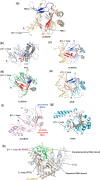Structure of human RNA N⁶-methyladenine demethylase ALKBH5 provides insights into its mechanisms of nucleic acid recognition and demethylation
- PMID: 24489119
- PMCID: PMC3985658
- DOI: 10.1093/nar/gku085
Structure of human RNA N⁶-methyladenine demethylase ALKBH5 provides insights into its mechanisms of nucleic acid recognition and demethylation
Abstract
ALKBH5 is a 2-oxoglutarate (2OG) and ferrous iron-dependent nucleic acid oxygenase (NAOX) that catalyzes the demethylation of N(6)-methyladenine in RNA. ALKBH5 is upregulated under hypoxia and plays a role in spermatogenesis. We describe a crystal structure of human ALKBH5 (residues 66-292) to 2.0 Å resolution. ALKBH5₆₆₋₂₉₂ has a double-stranded β-helix core fold as observed in other 2OG and iron-dependent oxygenase family members. The active site metal is octahedrally coordinated by an HXD…H motif (comprising residues His204, Asp206 and His266) and three water molecules. ALKBH5 shares a nucleotide recognition lid and conserved active site residues with other NAOXs. A large loop (βIV-V) in ALKBH5 occupies a similar region as the L1 loop of the fat mass and obesity-associated protein that is proposed to confer single-stranded RNA selectivity. Unexpectedly, a small molecule inhibitor, IOX3, was observed covalently attached to the side chain of Cys200 located outside of the active site. Modelling substrate into the active site based on other NAOX-nucleic acid complexes reveals conserved residues important for recognition and demethylation mechanisms. The structural insights will aid in the development of inhibitors selective for NAOXs, for use as functional probes and for therapeutic benefit.
Figures







References
-
- Carell T, Brandmayr C, Hienzsch A, Muller M, Pearson D, Reiter V, Thoma I, Thumbs P, Wagner M. Structure and function of noncanonical nucleobases. Angew. Chem. Int. Ed. Engl. 2012;51:7110–7131. - PubMed
-
- Sibbritt T, Patel HR, Preiss T. Mapping and significance of the mRNA methylome. Wiley Interdiscip. Rev. RNA. 2013;4:397–422. - PubMed
Publication types
MeSH terms
Substances
Associated data
- Actions
Grants and funding
LinkOut - more resources
Full Text Sources
Other Literature Sources
Molecular Biology Databases

